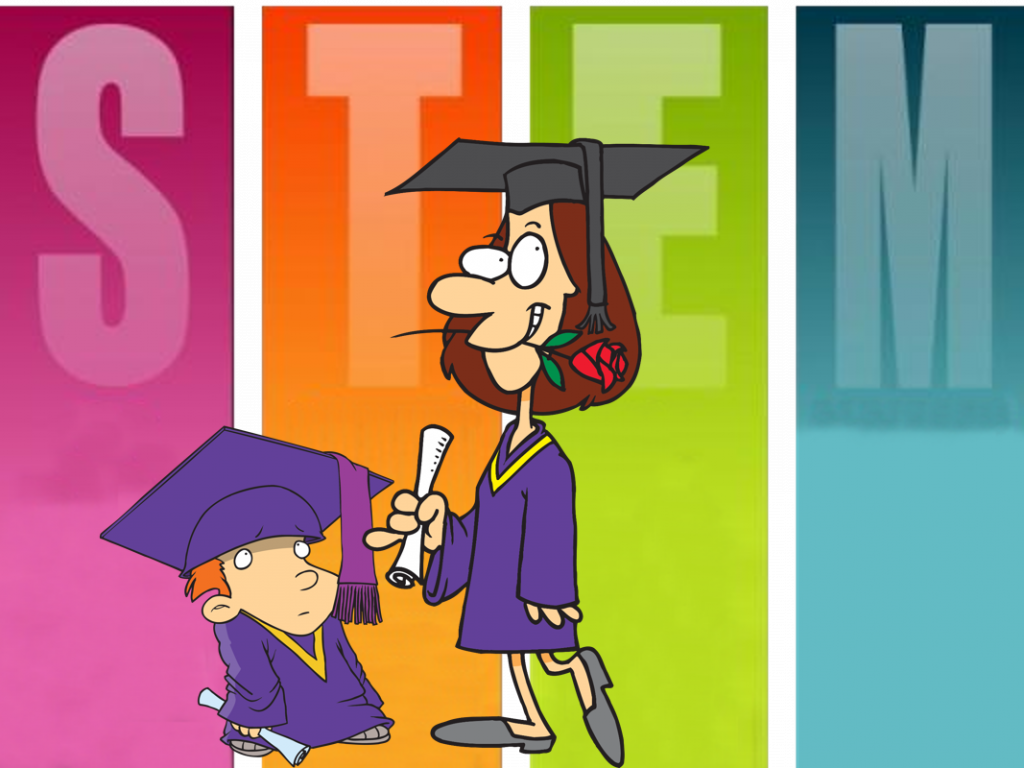As parents, we want our children to learn everything they will need to become successful adults. In today’s technological world, more often than not that means they will need a good background in science, technology, engineering, and mathematics (STEM). Lilian Barnard, Microsoft’s South African Director of the Public Sector, predicts “by 2020 about 80% of all jobs will require young people to have some sort of STEM education.”[1] Even for jobs not requiring STEM per se, the critical thinking and problem-solving skills learned during STEM classes will provide a lifetime of benefits. We really don’t know what jobs our children will be filling. Ryan Petersen (@RyanPete) explains, “School has always been a place to train students for their eventual adult lives. Cultural norms have long dictated the foundation they need to survive in society and the workforce — reading, writing, math and science. Now, more than ever, that training mission is evolving and seems akin to rocketing them into space rather than keeping their feet grounded. That’s because today’s schools are preparing students for careers we haven’t yet imagined. In fact, according to a 2017 report by Dell, 85 percent of the jobs that will exist in 2030 haven’t even been invented yet.”[2]
When should STEM education begin?
More and more subject matter experts are encouraging parents to help prepare their children become lifelong learners even before their formal education journey begins. James Heckman (@heckmanequation), a Nobel laureate economist and University of Chicago economics professor, completed a study on early childhood education and concluded, “Investing in early childhood education offers substantive benefits both in terms of the economy and of healthier and better prepared students and families.”[3] Dian Schaffhauser (@Schaffhauser), reports, “A new science brief has suggested that quality STEM experiences in pre-K through grade 3 can offer a ‘critical foundation for learning about these disciplines in ways that facilitate later learning.’ Young children, according to the report, can engage in math reasoning and even explain their math thinking; make sense of concepts such as length, area and volume; explore scientific ideas, such as cause and effect; and begin learning and communicating about engineering concepts, such as form and function.”[4]
The report to which Schaffhauser refers was published by the Community for Advancing Discovery Research in Education (CADRE), a group funded by the National Science Foundation. The study concludes, “Learning in the STEM disciplines, done well, is rich in experiences, problem-solving, and communication. It provides natural opportunities for language development and use. Young children begin the process of developing conceptual understanding through investigating, discussing, reading, and writing about STEM-related ideas and phenomena. They are capable of broad and deep learning in STEM if provided with coherent, consistent instruction over years.”[5] I appreciate the fact they stress STEM education done well includes experiences, problem-solving, and communication. To get children, especially younger children, excited about STEM subjects requires hands-on projects. That’s why I, along with a few colleagues, founded The Project for STEM Competitiveness — to help get a project-based, problem-solving approach into schools near where we live.
What does STEM involve?
Too often, the term STEM is simply tossed out as an acronym with little explanation beyond what the letters stand for. The CADRE document explains what is involved in each discipline:
- Science is the study of the natural world, seen and unseen. Science includes what scientists and children who are doing science learn (concepts and
crosscutting ideas) and how they go about learning it (the practices of science). - Technology involves the application of scientific knowledge for practical purposes, such as to improve productivity, make things, or provide services. It includes all human-made objects — basic and advanced, non-digital and digital — that support us in work and in our daily lives.
- Engineering is the process of designing to meet human needs and wants under various constraints such as time, money, available materials, and the laws of nature. Engineering has strong connections to many other disciplines, particularly mathematics, science, and technology.
- Mathematics is the study of quantity, structure, shape, and change. It provides a foundation for many aspects of daily life, including for much of science, technology, and engineering. The mathematical sciences include more than numbers and arithmetic — they also deal with such topics as geometrical figures and structures, measurement, and logical argumentation. Mathematicians and children doing math use the practices of mathematics to identify crosscutting patterns and structures and to understand and explain phenomena.
Despite recent encouragement to expose children to more STEM subjects, Sasha Jones reports a recent study “found K-3 students spend on average 57 minutes a day on math and 18 minutes on science, compared with 89 minutes on reading/language arts. In grades 4-6, that number increases to 63 minutes on math and 27 minutes on science. Moreover, science is taught less frequently, with 17 percent of K-3 classes and 35 percent of classes in grades 4-6 receiving science instruction all or most days, every week of the school year.”[6] We need to do better.
Concluding thoughts
According to the CADRE study, early STEM education provides the following benefits:
- Promotes socio–emotional development. “Doing quality STEM leads to social and emotional growth and fewer challenging behaviors.” I’m assuming this is true because “quality STEM” education involves hands-on experience in a group setting. Getting children to work together to solve problems is great training for life.
- Supports the development of STEM-related habits of mind. “These habits of mind include curiosity, critical thinking, communication, collaboration, persistence, problem-solving, and positive attitudes toward science and mathematics.” Children are naturally curious and STEM done well can encourage even more curiosity.
- Helps with later learning in all subjects. “Learning and doing science and mathematics contributes to gains in those subjects, supports literacy and language development, and is associated with increased reading comprehension and stronger writing skills. These improvements carry over into subsequent grades, and in mathematics, they can predict later achievement.” Successful people are unfailingly lifelong learners.
- Benefits students from all backgrounds. Children who are non-English speakers, for example, can engage in powerful science explorations that help them build knowledge and understanding in STEM while they are learning English. These experiences can place low language demands on children and provide them with opportunities to hear, gain understanding of, and use common English vocabulary, as well as STEM-specific language (e.g., area, properties, force, pattern), in context.” According to educators, “Mathematics is the only language shared by all human beings regardless of culture, religion, or gender.”
Petersen concludes, “It’s imperative that schools lead the way, not just in offering stronger STEM programming, but in advocating for it with the community and championing it with students — especially at the K–12 level where they are first exposed to it.”
Footnotes
[1] Staff, “By 2020 almost 80% of jobs will require STEM education,” BusinessTech, 12 November 2018.
[2] Ryan Petersen, “STEM Helps Students Launch into the Future,” EdTech, 10 October 2018.
[3] Pat Donachie, “Report: Early childhood ed a good long-term investment,” Education Dive, 26 April 2017.
[4] Dian Schaffhauser, “Early STEM Provides ‘Critical Foundation’ for Future Learning,” STEAM Universe, 7 January 2019.
[5] Staff, “Considerations for STEM Education from PreK through Grade 3,” Community for Advancing Discovery Research in Education, 2018.





